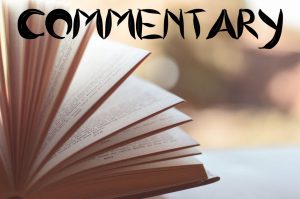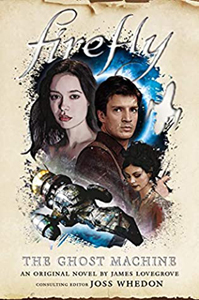After leaning into the Western side of sci-fi/Western in his first two “Firefly” novels, James Lovegrove uses sci-fi to good effect in “The Ghost Machine” (March). His first effort, “Big Damn Hero,” includes cargo that could blow up if handled improperly.
But “Ghost Machine” features a more thematically interesting crate: the titular Blue Sun sonic weapon that makes people passive. The way it does so is by sending them into dreamland; first, their dreams are pleasant, but then they turn dark.
(Side note: While this is listed as No. 4 among “Firefly” novels, it’s the third published. Tim Lebbon’s “Generations,” labeled as No. 3, is listed as an October 2020 release.)

“Firefly: The Ghost Machine” (2020)
Author: James Lovegrove
Series: “Firefly” No. 3
Setting: Between TV series and film
YA-style writing
Before we enter everyone’s dream worlds, “The Ghost Machine” starts with some of Lovegrove’s weakest young-adult style writing. Mal leaves Jayne in the desert till he behaves, and Kaylee calls Mal by his name instead of “Captain.” The dialog of Badger and Niska, with Lovegrove phonetically emphasizing their accents yet having them unnaturally deliver exposition, also makes for rough reading.
When everyone on Serenity starts dreaming, “Ghost Machine” gets good. And gradually, it gets really good. Lovegrove creates distinct worlds for each crew member based on their deepest hopes. These are daydreams but they don’t use bizarre dream logic – except when they turn into nightmares and a mistrustful dreamer imagines the worst about a trusted ally.
I got swept up in the stakes of each story; even though these things aren’t really happening, the Serenity will crash into a moon unless someone wakes up to put the ship back on a safe trajectory. River, apparently not yet having been trained to fly the ship in this story set between the TV series and film, enters everyone’s dreams to wake them up.
Dark dreams
This format is perfect for getting at the inner truths of these seven people. Mal dreams of family life with Inara and their three kids. Jayne is happy being on the ranch with his mom and younger brother, who has miraculously been cured of damplung. Simon’s awkwardness around Kaylee is gone, and they are comfortably dating.
Wash is the one male crew member whose romantic or familial relationship is the same in his dream as in reality – Zoe is already the woman of his dreams – but his dream is a “careful what you wish for” morality play as he’s also rich. Similarly, Kaylee is doing what she loves: fixing vehicles. Zoe imagines a world where the Independents won the war.
It’s fascinating to watch these dreams turn dark – extremely dark in some cases, notably the violence of Jayne’s story as the Cobbs face off against cattle thieves. In some threads, we find loved ones and trusted friends turn on the dreamer.
Lovegrove revels in the freedom of writing in dreamscapes, but this isn’t a case where anything goes. While some dreams are in an alternate “past” and some are in an alternate “present,” the narratives are straightforward, as they’d be in the real world. Rather, the author uses his freedom to have extreme things happen with behaviors and situations.

Sort of like ‘The Wish’
If these were real-world stories, we might ask if someone is behaving in character. For example, does Zoe really have a mistrustful streak in regard to Mal and Book? She doesn’t have any reason to, but because dreams operate in the subconscious rather than the conscious, weird things are allowed to happen. Among those “weird” things: River is clear-headed in dream space.
The obvious Whedonverse comparison here is to “Buffy’s” “The Wish,” in that everyone ultimately imagines a world that’s worse than reality. Even if their reality is fairly bleak – always worrying about the next job, etc. – at least they have each other.
The actors – particularly Summer Glau playing River as “normal” and others getting to play their characters’ dark halves – could’ve had a blast.
Even though these are dreams, the people feel a residual ache from the subconscious imaginings, and I suspect this would’ve made for powerful viewing.
If “The Ghost Machine” had been a “Firefly” episode, I can see it holding a similar place in the lore as “The Wish” does for “Buffy.”

